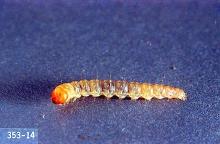Chrysoteuchia topiaria
Pest description and crop damage Moths have protruded snouts projecting from the head. Moths are about 0.33 inch in length with colorful iridescent scales on the wings and body. Eggs are scattered on plant crowns and the soil surface.
Larvae are creamy white or pinkish with a light brown head. Small hooks on the abdominal prolegs are in circles or ovals, distinguishing them from armyworms or cutworms whose hooks are in a line. Larvae feed on and in crowns and roots of most grasses and can seriously injure established stands wherever grass is grown for seed.
Biology and life history Moths fly from June through July. A smaller flight is noted in the fall in some years. Larvae feed on crowns from late June through late October to early November. Most larvae have finished feeding and are in cocoons by late October. Pupae form the next spring, and moths emerge shortly thereafter. This species has one generation a year. Other species of sod webworm whose larvae feed in the fall and may continue feeding in the spring prior to pupating may also infest grasses.
Sampling and thresholds Pheromone traps baited with cranberry girdler pheromone can be used to monitor populations of moths. Place two to four traps at canopy height in fields beginning in mid-June. Larval injury has been noted when captures exceed 50 to 75 moths per trap in any 5-day period (usually June 20 to July 15 in western Oregon). Sample for larvae in early September to determine the need for control. From two to six per crown can result in damage.
Management-biological and cultural control
- Diseases and bird predation significantly reduce larval populations from October through March. Unfortunately, these natural controls usually occur after most damage has been done.
- Endophyte-containing turf varieties of grasses may help reduce populations.
Management-chemical control
Larval control-Apply insecticides in September with irrigation (western Oregon) when larvae are small and easier to control. Applications in late October and later are not effective, as most of the population has ceased feeding and begun dormancy in cocoons. Dryland grass production: rainfall at application is absolutely necessary for these products to be effective on this pest. Otherwise product does not reach larvae to control them.
- bifenthrin (Brigade 2EC and WSB) at 0.1 lb ai/A. Apply in early fall and/or spring when larvae are active. Best results are achieved with 25 to 40 gal spray solution per acre followed by irrigation or rainfall. Maximum amount allowed is 0.2 lb ai/A per season but no more than once every 14 days. PHI 30 days prior to harvest for forage, hay and seed.
- gamma-cyhalothrin (Declare) at 0.01 to 0.015 lb ai/A. REI 24 hr. PHI 7 days. Do not exceed 0.045 lb ai/A per season. IRAC group 3. Restricted use pesticide.
- cyfluthrin (Baythroid XL) at 0.0125 to 0.022 lb ai/A. PHI 0 days. REI 12 hr. Maximum amount allowed per 5-day interval is 0.022 lb ai/A. Maximum amount allowed per crop season is 0.089 lb ai/A.
- lambda-cyhalothrin (Warrior) at 0.02 to 0.03 lb ai/A. PHI 0 days for grazing and cut for forage, 7 days for straw and seed crop. REI 24 hr.
- lambda-cyhalothrin/chlorantraniliprole (Besiege) at 6.0 to 10.0 fl oz/A. PHI 0 days for grazing and cut for forage, 7 days for straw and seed crop. REI 24 hr. Do not exceed a total of 27.0 fl oz of Besiege or 0.09 lb ai of lambda-cyhalothrin-containing products or 0.2 lb ai of chlorantraniliprole-containing products per acre per year.
- zeta-cypermethrin (Mustang Maxx, and Mustang) at 0.028 to 0.05 lb ai/A Mustang and at 0.014 to 0.025 lb ai/A for Mustang MAXX. PHI 7 days for seed screenings. REI 12 hr. For forage and hay use no more than 0.10 lb ai/A per season; make subsequent applications no closer than 7 days. For straw and seed screenings use no more than 0.125 lb ai/A per season; make subsequent applications no closer than 17 days. IRAC group 3A.


